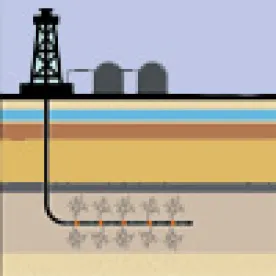On December 13, 2016, the U.S. Environmental Protection Agency (EPA) released its voluminous final report on hydraulic fracturing. U.S. EPA, Hydraulic Fracturing for Oil and Gas: Impacts from the Hydraulic Fracturing Water Cycle on Drinking Water Resources in the United States (Final Report). U.S. Environmental Protection Agency, Washington, D.C., EPA/600/R-16/236F, 2016. Hydraulic fracturing (or fracking) involves pumping fluid, typically water mixed with chemicals and sand, down an oil or gas production well under pressure great enough to fracture oil- and/or gas-bearing rock. The fluid contains materials that help to keep fractures open to allow production of oil or gas from the formation through the well bore where it is collected and managed at the surface.
The Final Report is a product of five years of work and represents the culmination of EPA's study of the potential impacts of hydraulic fracturing in oil and gas exploration and production on drinking water resources. Final Report at ES-3. The Final Report concludes that fracking activities "can impact drinking water resources under some circumstances." Id. The Final Report notes that the following combinations of activities and factors are more likely than others to result in more frequent or more severe impacts:
-
Water withdrawals as a source of injection fluids for hydraulic fracturing in times or areas of low water availability, particularly in areas with limited or declining water resources;
-
Spills during the management of hydraulic fluids and chemicals or produced water that results in large volumes or high concentrations of chemicals reaching groundwater resources;
-
Injection of hydraulic fracturing fluids into wells with inadequate mechanical integrity, allowing gases or liquids to move to groundwater resources;
-
Injection of hydraulic fracturing fluids directly into groundwater resources;
-
Discharge of inadequately treated hydraulic fracturing wastewater to surface water resources; and
-
Disposal or storage of hydraulic fracturing wastewater in unlined pits, resulting in contamination of groundwater resources.
Id.
In contrast to the Final Report, the draft report appeared more definitive in its determination regarding the risks associated with hydraulic fracturing, finding no "widespread, systemic" impacts associated with fracking. U.S. EPA, Assessment of the Potential Impacts of Hydraulic Fracturing for Oil and Gas on Drinking Water Resources, June 2015 (Draft Report). The Final Report, however, did not include that phrase because (1) EPA determined it did not have sufficient quantitative data and (2) because the phrase did not "really communicate the findings in the report." Fracking Can Taint Drinking Water, EPA Report Finds, Wall Street Journal, December 13, 2016 (WSJ Article) (quoting Thomas Burke, EPA Deputy Assistant Administrator, on a conference call with reporters). In the Draft Report, EPA found that known cases of impacts to drinking water were "small compared to the number of hydraulically fractured wells." Draft Report at ES-6. Mr. Burke explained that "[w]hile the number of identified cases of drinking water contamination is small, the scientific evidence is insufficient to support estimates of the frequency of contamination." WSJ Article. The Final Report's conclusion, as noted above, is more broadly worded and avoids the appearance of a determination on the weight of the risks of fracking activities, stating that such activities "can impact drinking water resources under some circumstances." Final Report at ES-3.
Industry leaders have criticized the EPA for its revisions in the Final Report. Erik Milito, Upstream Director at the American Petroleum Institute (API), the largest oil and natural gas trade group in the U.S., stated that "It is beyond absurd for the administration to reverse course on its way out the door." WSJ Article. Environmentalists, on the other hand, were more complimentary regarding the Final Report. Mark Brownstein, Vice President for Climate and Energy at the Environmental Defense Fund, stated that "The revised assessment puts an end to the false narrative of risk-free fracking that has been widely promoted by the industry." Id.
A copy of the the full Final Report is located at www.epa.gov/hfstudy.




 />i
/>i

